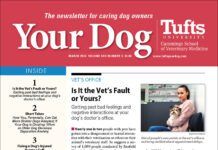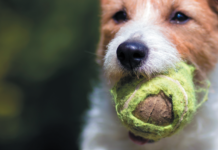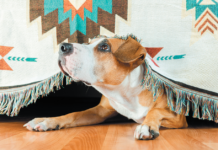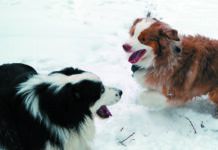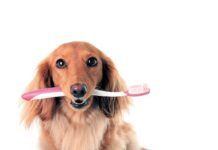How to Keep a Dog from Climbing the Canine Ladder of Aggression
Dogs don’t act aggressively to strut their stuff or show who’s dominant. That’s a human thing. Canine aggression is a response to what a dog perceives as a threat. With aggressive behavior, the dog is trying to deflect the threat and restore harmony. Dogs so want harmony, in fact, that most of the rungs on the Canine Ladder of Aggression, a graphic devised by British veterinary surgeon and behaviorist Kendal Shepherd, BVSc, are not acts of aggression at all but signs of appeasement. They include such behaviors as yawning, nose licking, and turning away. They all mean “I’m uncomfortable; you’re making me anxious. Can you please stop doing the thing that’s making me feel stressed and unsafe?”
Letting a dog know that his canine housemate has died
Q: I have three senior dogs who have always been together sharing everything. At some point, one will die or, more likely, need to be put down. What is the best way of letting the other two know that one has passed and will not be coming home? If the dog has to be euthanized at the vet’s office, should I bring all three with me so that the others know their friend has passed?
Librela injections for arthritis
Q: We have an 11-year-old pit bull mix who has a moderate case of arthritis in his legs and shoulders. We have tried cold laser therapy once a week for a few months, but the positive effects fade after a few days. We also have tried a few pain and anti-inflammatory medications prescribed by our veterinarian, but our dog, Ipo, gets digestive upset from all of them. Now our vet is suggesting Librela injections once a month; he highly recommends them. But since Librela is relatively new (especially to us), we would love to see what your veterinary team thinks about its safety, side effects, and efficacy. Thank you.
Download The Full March 2024 Issue PDF
- Is It the Vet’s Fault or Yours?
- Short Takes
- Fixing a Dog’s Injured Rotator Cuff
- The Safest Way to Break Up a Dog Fight Involves Resisting Your Instincts
- A Surefire Way to Ratchet Down Your Dog’s Pain
- Dental Sealants to Help Your Dog Avoid Gum Disease?
- Dear Doctor: Neighbor threatens to shoot aggressive dog
Is It the Vet’s Fault or Yours?
Nearly one in two people with pets have gotten into a disagreement or heated interaction with their veterinarian or others on their animal’s veterinary staff. So suggests a survey of 1,000 people conducted by Banfield Hospital, which offers veterinary services in 42 states. At the same time, a separate survey of more than 1,300 veterinarians conducted by the American Veterinary Medical Association (AVMA) indicates that nine in 10 veterinary professionals have experienced negative or “escalating” client interactions. Perhaps the pandemic and its tribulations have contributed to this slide toward mutual antagonism, but whatever the cause, it is painfully clear that not all is hunky dory at your dog’s doctor’s office.
How You, Personally, Can Get More Shelter Dogs Adopted
Taking a shelter dog for an outing of just a few hours or fostering the animal for a night or two significantly increases the dog’s chance of being adopted — and not by you. When dogs are seen in the community and their short-term caregivers share these animals’ stories, people step up to take home the canines as permanent pets.
If Your Dog is Choking
A choking dog is an emergency. An animal has to be able to breathe. Before rushing to the vet, first try the following.
When an Older Dog Develops Separation Anxiety
If a dog who has never minded your leaving the house without her suddenly develops separation anxiety when she is older, get her to the doctor. Much of the time, it’s a medical issue that triggers the problem. The dog is in pain for some reason, and she now becomes anxious and insecure in your absence. If the pain interferes with her physical functioning, it can undermine her security all the more. Often, but not always, such a dog had sub-clinical separation anxiety in her younger years that simply was never picked up.
Fixing a Dog’s Injured Rotator Cuff
You play tennis long enough, you will likely tear your rotator cuff,” says Tufts veterinary orthopedist Michael Kowaleski, DVM. “A dog does dog things long enough — landing on his front legs jumping down the stairs, and so on — and the shoulder cuff can eventually get torn that way, too.”
The Safest Way to Break Up a Dog Fight Involves Resisting Your Instincts
Dogs are lovers, not fighters. They are genetically primed to get along with each other — to explore together, to play with each other, and to relax in each other’s presence. But some dogs haven’t been socialized to understand other dogs. They may have had a bad experience with another dog as a puppy that was imprinted on their psyche very young, or they may not be feeling well. As a result, they can become anxious and prone to misunderstand cues from other dogs. And that can make them aggressive — to the point that they feel they have to attack to stay safe, even if they have not been provoked.
A Surefire Way to Ratchet Down Your Dog’s Pain
When your dog is off leash and won’t come back to you, your natural inclination may be to yell or show exasperation in some other way. It’s understandable. Dogs are faster than we are, and it induces anxiety when they’re in a situation that we can’t control physically. But doing a quick self-check and taking the lead by acting calmly will always serve your pet — and you — better. He’s more likely to return to you if he sees you’re not angry. He’ll be more likely to comply in general if you don’t make a bad situation worse by exhibiting displeasure that will only leave him anxious or confused. But were you aware that not losing it with a hand-wringing response will also serve your dog when he is in pain?
Dental Sealants to Help Your Dog Avoid Gum Disease?
When a person gets dental sealants, they are applied directly to the chewing surfaces of the teeth — the molars, specifically — to help prevent cavities and other forms of dental disease. The teeth have little fissures, or grooves, that trap food residue (often sticky in nature) and pave the way for tooth decay. The sealants keep the grooves covered and may stay in place for a person’s lifetime.








